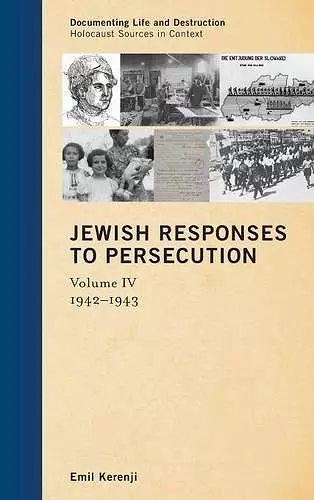Jewish Responses to Persecution
1942–1943
Format:Hardback
Publisher:Rowman & Littlefield
Published:10th Oct '14
Currently unavailable, and unfortunately no date known when it will be back

With its unique combination of primary sources and historical narrative, this volume provides an important new perspective on Holocaust history. Covering the peak years of the Nazi “Final Solution,” it traces the Jewish struggle for survival, which became increasingly urgent in this period, including armed resistance and organized escape attempts. Shedding light on personal and public lives of Jews, the book provides compelling insights into a wide range of Jewish experiences during the Holocaust. Jewish individuals and communities suffered through this devastating period and reflected on the Holocaust differently, depending on their nationality, personal and communal histories and traditions, political beliefs, economic situation, and other circumstances. The rich spectrum of primary source material collected, including letters, diary entries, photographs, transcripts of speeches and radio addresses, newspaper articles, drawings, and institutional memos and reports, makes this volume an essential research tool and curriculum companion.
This impressive series provides a sense of the depth and diversity of contemporary Jewish documents while embedding them in explanatory narratives. . . .Volume IV covers 1943, a crucial year in the chronology of genocide and also in terms of the Jewish responses to it. It was the year that genocide engulfed most of its victims, and a plethora of documents show just how suddenly and forcefully it did. . . . Even as it focuses on the darkest period of the Holocaust, Volume IV remains dedicated to exploring the diverse experiences of various Jewish populations. * Yad Vashem Studies *
Similar to the preceding volumes in the Jewish Responses to Persecution-series, this book offers not only a wide-ranging panorama of Jewish experiences and responses, but also a unique link between historical narrative and documentation. . . .The book comprises an extraordinarily broad spectrum of sources – from letters to diary entries, photographs, and newspaper entries to publications by Jewish councils – that was produced for the most part during the war, in some instances in the early post-war period. Drawing primarily from the rich archival collections of the U.S. Holocaust Memorial Museum, the editor’s careful translations open up to American readers documents written in a variety of languages. Kerenji integrates his well-edited and contextualized sources into a broader story that makes for a compelling read. But the volume’s clear structure also facilitates a targeted search for documents on specific topics or time periods while individual sources can be located via a document list. With its valuable bibliographic leads, the book provides guidance to a field of research not even specialists on the Holocaust can fully fathom any more. A glossary, several maps, a chronology, and a detailed index round out this extremely thorough edition. -Translated from German * Zeitschrift für Geschichtswissenschaft *
Through sheer diversity of perspectives, this rich collection of sources challenges the way we tell the history of the Holocaust and of the Jewish responses to it. There was no ‘typical’ experience, nor was there one single timeline of events. The great achievement of this volume is to introduce an astonishing array of individuals, extraordinary precisely because they were so ‘ordinary,’ who struggled to anticipate what was still—for them—an unknown and open-ended future. The remarkable range of sources are moving in their emotional power. The brilliant narrative in which they are embedded is illuminating and consistently alive to the complexities of historical circumstance. Scholars, teachers, and students of the Holocaust will find this book to be essential reading and an invaluable resource. -- Paul Hanebrink, Rutgers University
This important volume contains judiciously selected, riveting documents that illustrate the complexity of Jewish responses to persecution, partly because the timing and nature of Nazi-directed mass murder varied significantly from one place to another. The author shows that in September 1942 a Jew in Warsaw was likely to be deported to a death camp, but a Jew in Paris could attend High Holiday services, and one in Budapest might have gone to the cinema. All were ultimately doomed, but Nazi policies kept them uncertain of their fate. The book is pitched exactly right for a wide range of readers, including college students, an attentive general audience, and scholars. -- Zvi Y. Gitelman, University of Michigan
ISBN: 9781442236264
Dimensions: 237mm x 160mm x 40mm
Weight: 1061g
598 pages